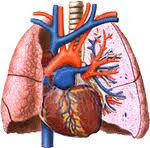What is pulmonary circulation
What is high blood pressure in the pulmonary circulation?
Pulmonary circuit goes from the right ventricle and into the lungs via the pulmonary artery and are derived in lung tissue. Collecting Veins (veins) causes the blood back to the left atrium of the heart. The right ventricle which pumps blood into the pulmonary circulation. Conversely, the sinistral ventricle which pumps blood out into the wide circulation. Most cases of heart failure due to failure of the left ventricle, less frequently occurring failure of the right ventricle.
High blood pressure in the pulmonary circulation, pulmonary hypertension, is a complex issue characterized by nonspecific symptoms and signs and with many possible causes. The unknown cause is primary pulmonary hypertension. The known cause is secondary pulmonary hypertension.
Prolonged high blood pressure in the pulmonary circulation leads to the development of a condition called cor pulmonale (cor = heart pulmonary = lungs that have to do). It is a condition in which the right ventricle is enlarged because this part of the heart has to pump out the blood with greater force to be able to drive the blood through the pulmonary circulation. Cor pulmonale can cause both acute and chronic. The sequela of cor pulmonale is failing right ventricle, a right-sided heart failure.
Untreated high blood pressure in the pulmonary circulation, for whatever reason, will result in right-sided heart failure.










0 comments:
Post a Comment